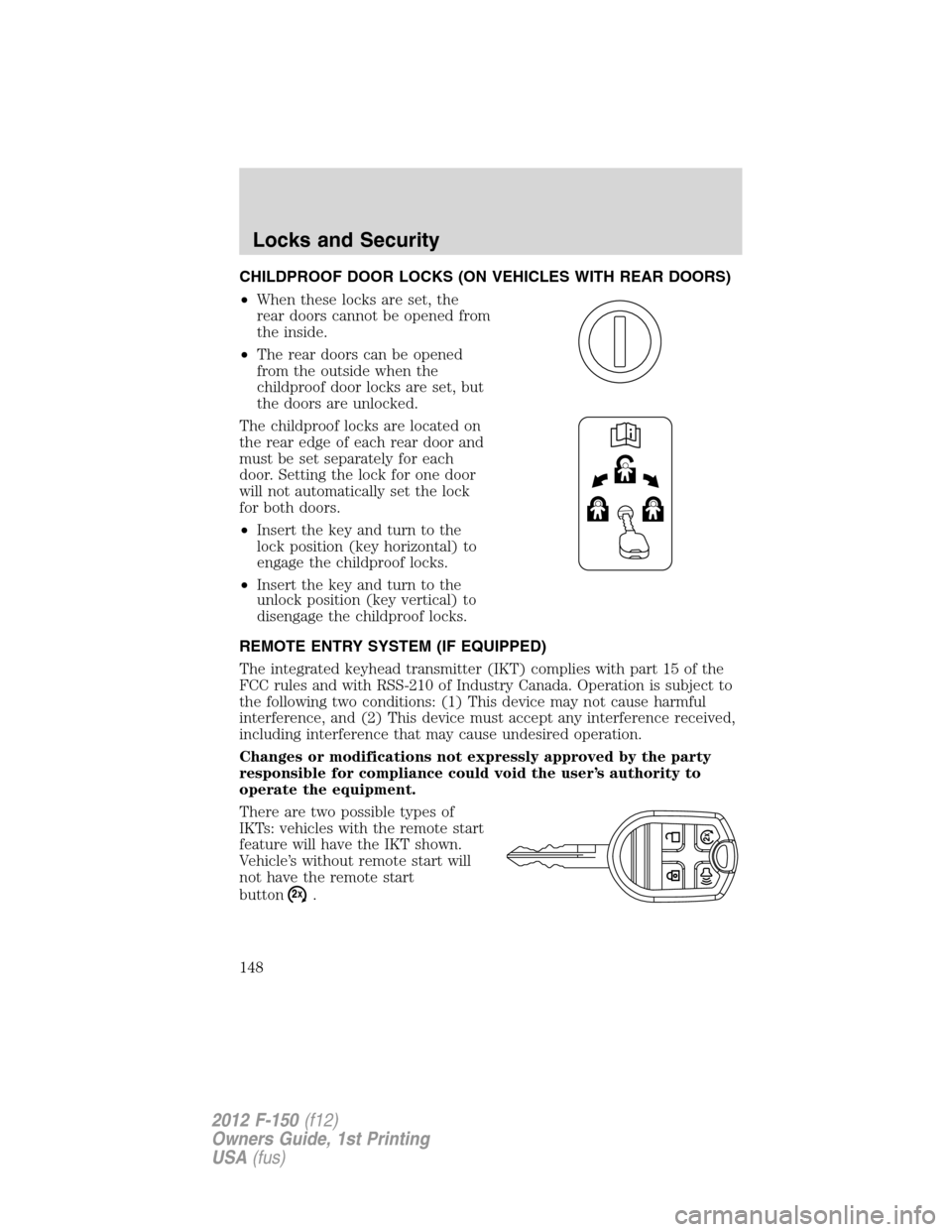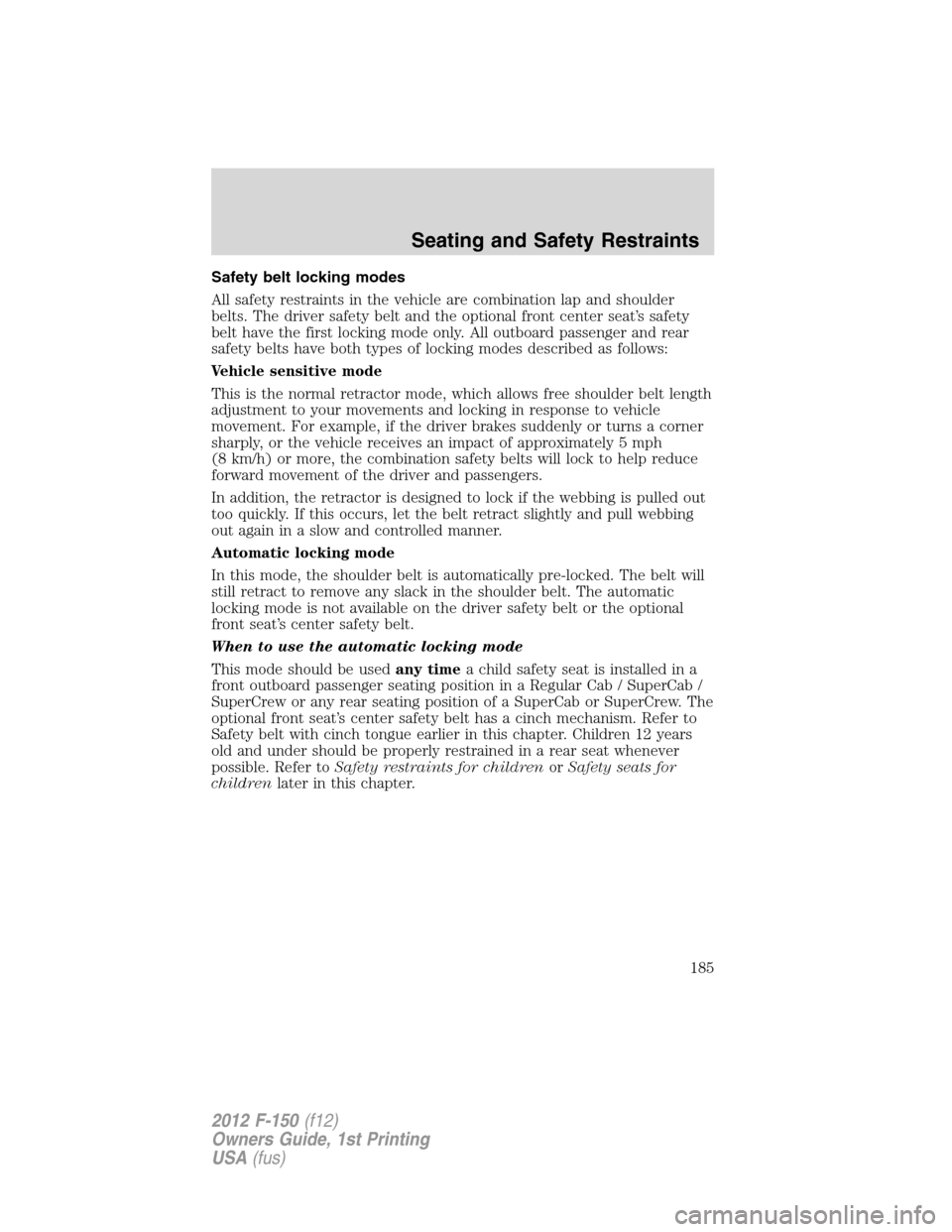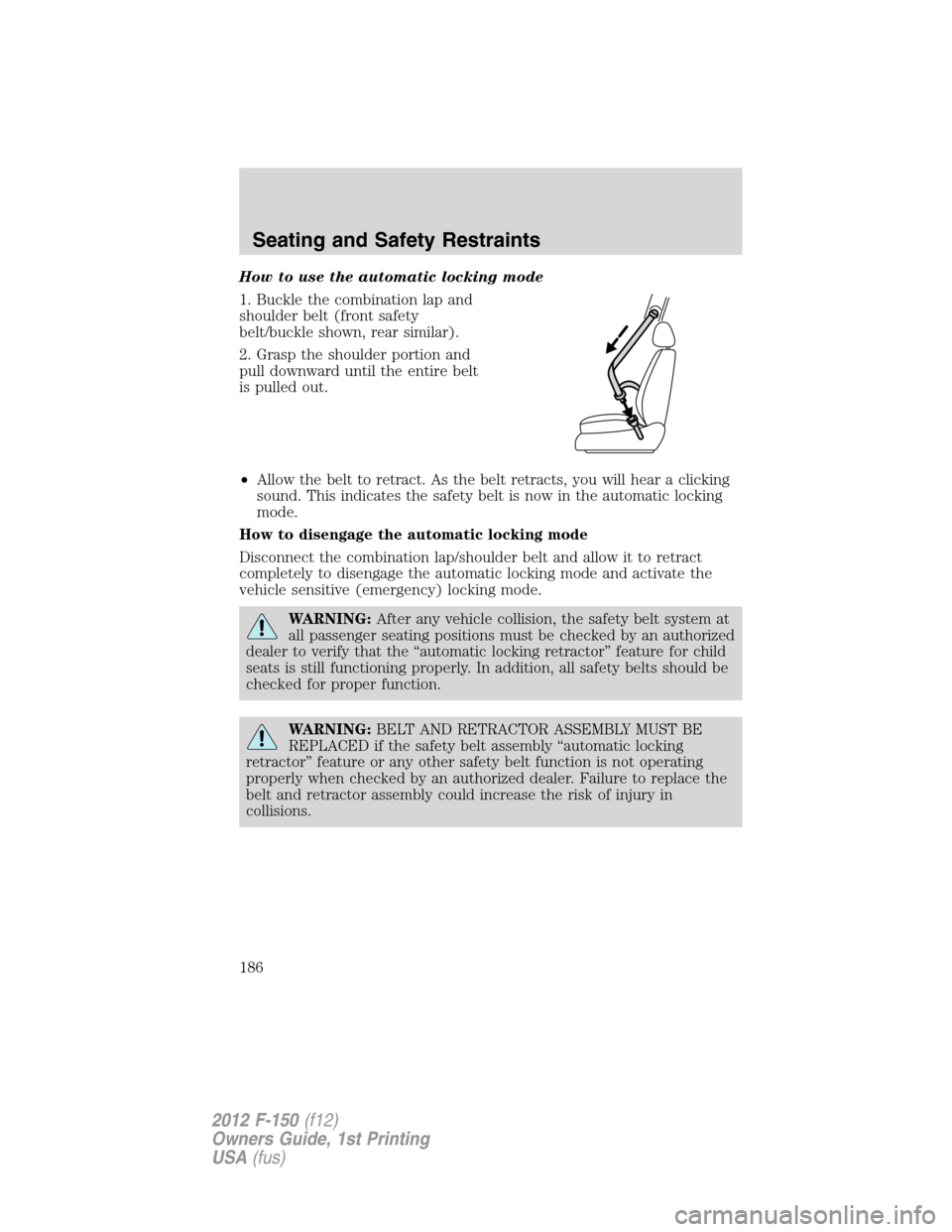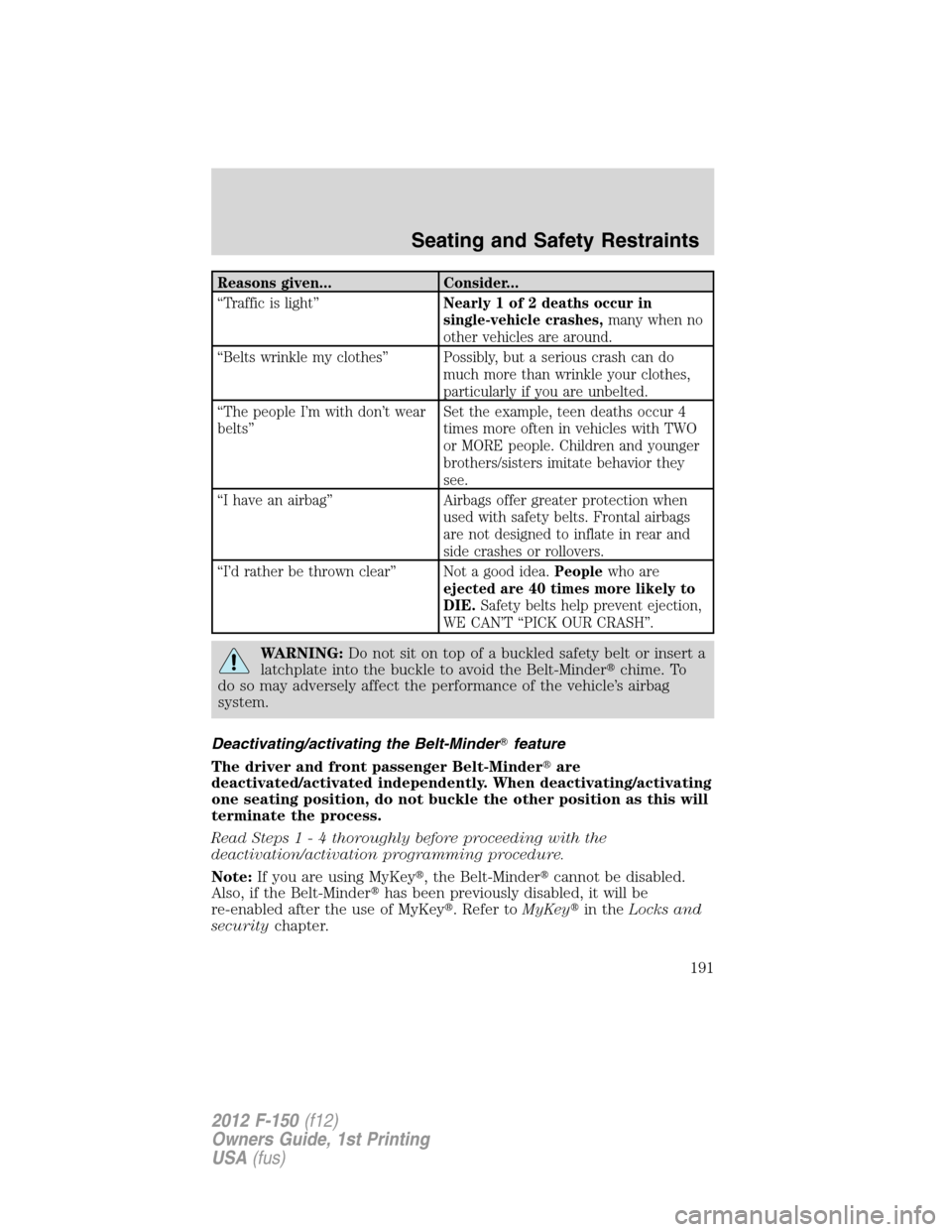Page 2 of 462
Locks and Security 136
Keys 136
Locks 144
Anti-theft system 156
Seating and Safety Restraints 160
Seating 160
Personal Safety System™ 177
Safety belt system 180
Airbags 193
Child restraints 209
Tires, Wheels and Loading 230
Tire information 233
Tire inflation 235
Tire Pressure Monitoring System (TPMS) 248
Vehicle loading 255
Trailer towing 263
Trailer brake controller-integrated 270
Recreational towing 276
Driving 278
Starting 278
Brakes 284
AdvanceTrac�286
Transmission operation 299
Reverse sensing system 304
Rear-view camera system 306
Roadside Emergencies 326
Getting roadside assistance 326
Hazard flasher control 327
Fuel pump shut-off 328
Fuses and relays 328
Changing tires 338
Wheel lug nut torque 346
Jump starting 347
Wrecker towing 350
Table of Contents
2
2012 F-150(f12)
Owners Guide, 1st Printing
USA(fus)
Page 10 of 462
These are some of the symbols you may see on your vehicle.
Vehicle Symbol Glossary
Safety Alert
See Owner’s Guide
Fasten Safety BeltAirbag - Front
Airbag - SideChild Seat Lower
Anchor
Child Seat Tether
AnchorBrake System
Anti-Lock Brake SystemParking Brake System
Brake Fluid -
Non-Petroleum BasedParking Aid System
Stability Control SystemSpeed Control
Master Lighting SwitchHazard Warning Flasher
Fog Lamps-FrontFuse Compartment
Fuel Pump ResetWindshield Wash/Wipe
Windshield
Defrost/DemistRear Window
Defrost/Demist
Introduction
10
2012 F-150(f12)
Owners Guide, 1st Printing
USA(fus)
Page 11 of 462
Vehicle Symbol Glossary
Power Windows
Front/Rear
Power Window Lockout
Child Safety Door
Lock/UnlockInterior Luggage
Compartment Release
Panic AlarmEngine Oil
Engine CoolantEngine Coolant
Temperature
Do Not Open When HotBattery
Avoid Smoking, Flames,
or SparksBattery Acid
Explosive GasFan Warning
Power Steering FluidMaintain Correct Fluid
LevelMAX
MIN
Service Engine SoonEngine Air Filter
Passenger Compartment
Air FilterJack
Check Fuel CapLow Tire Pressure
Warning
Introduction
11
2012 F-150(f12)
Owners Guide, 1st Printing
USA(fus)
Page 90 of 462
3. Loosen the three retaining bolts
(two at top of lamp, one at lower
inboard corner).
4. Once the three retaining bolts have been removed, slide the headlamp
assembly forward, disconnecting the two snap attachments at the fender.
5. Disconnect the electrical connector from the bulb by pulling rearward.
6. Remove the bulb and socket by
turning it counterclockwise, then
pull it straight out.
WARNING:Handle a halogen headlamp bulb carefully and keep
out of children’s reach. Grasp the bulb only by its plastic base
and do not touch the glass. The oil from your hand could cause the
bulb to break the next time the headlamps are operated.
Install the new bulb in reverse order.
Lights
90
2012 F-150(f12)
Owners Guide, 1st Printing
USA(fus)
Page 148 of 462

CHILDPROOF DOOR LOCKS (ON VEHICLES WITH REAR DOORS)
•When these locks are set, the
rear doors cannot be opened from
the inside.
•The rear doors can be opened
from the outside when the
childproof door locks are set, but
the doors are unlocked.
The childproof locks are located on
the rear edge of each rear door and
must be set separately for each
door. Setting the lock for one door
will not automatically set the lock
for both doors.
•Insert the key and turn to the
lock position (key horizontal) to
engage the childproof locks.
•Insert the key and turn to the
unlock position (key vertical) to
disengage the childproof locks.
REMOTE ENTRY SYSTEM (IF EQUIPPED)
The integrated keyhead transmitter (IKT) complies with part 15 of the
FCC rules and with RSS-210 of Industry Canada. Operation is subject to
the following two conditions: (1) This device may not cause harmful
interference, and (2) This device must accept any interference received,
including interference that may cause undesired operation.
Changes or modifications not expressly approved by the party
responsible for compliance could void the user’s authority to
operate the equipment.
There are two possible types of
IKTs: vehicles with the remote start
feature will have the IKT shown.
Vehicle’s without remote start will
not have the remote start
button
.
Locks and Security
148
2012 F-150(f12)
Owners Guide, 1st Printing
USA(fus)
Page 185 of 462

Safety belt locking modes
All safety restraints in the vehicle are combination lap and shoulder
belts. The driver safety belt and the optional front center seat’s safety
belt have the first locking mode only. All outboard passenger and rear
safety belts have both types of locking modes described as follows:
Vehicle sensitive mode
This is the normal retractor mode, which allows free shoulder belt length
adjustment to your movements and locking in response to vehicle
movement. For example, if the driver brakes suddenly or turns a corner
sharply, or the vehicle receives an impact of approximately 5 mph
(8 km/h) or more, the combination safety belts will lock to help reduce
forward movement of the driver and passengers.
In addition, the retractor is designed to lock if the webbing is pulled out
too quickly. If this occurs, let the belt retract slightly and pull webbing
out again in a slow and controlled manner.
Automatic locking mode
In this mode, the shoulder belt is automatically pre-locked. The belt will
still retract to remove any slack in the shoulder belt. The automatic
locking mode is not available on the driver safety belt or the optional
front seat’s center safety belt.
When to use the automatic locking mode
This mode should be usedany timea child safety seat is installed in a
front outboard passenger seating position in a Regular Cab / SuperCab /
SuperCrew or any rear seating position of a SuperCab or SuperCrew. The
optional front seat’s center safety belt has a cinch mechanism. Refer to
Safety belt with cinch tongue earlier in this chapter. Children 12 years
old and under should be properly restrained in a rear seat whenever
possible. Refer toSafety restraints for childrenorSafety seats for
childrenlater in this chapter.
Seating and Safety Restraints
185
2012 F-150(f12)
Owners Guide, 1st Printing
USA(fus)
Page 186 of 462

How to use the automatic locking mode
1. Buckle the combination lap and
shoulder belt (front safety
belt/buckle shown, rear similar).
2. Grasp the shoulder portion and
pull downward until the entire belt
is pulled out.
•Allow the belt to retract. As the belt retracts, you will hear a clicking
sound. This indicates the safety belt is now in the automatic locking
mode.
How to disengage the automatic locking mode
Disconnect the combination lap/shoulder belt and allow it to retract
completely to disengage the automatic locking mode and activate the
vehicle sensitive (emergency) locking mode.
WARNING:After any vehicle collision, the safety belt system at
all passenger seating positions must be checked by an authorized
dealer to verify that the “automatic locking retractor” feature for child
seats is still functioning properly. In addition, all safety belts should be
checked for proper function.
WARNING:BELT AND RETRACTOR ASSEMBLY MUST BE
REPLACED if the safety belt assembly “automatic locking
retractor” feature or any other safety belt function is not operating
properly when checked by an authorized dealer. Failure to replace the
belt and retractor assembly could increase the risk of injury in
collisions.
Seating and Safety Restraints
186
2012 F-150(f12)
Owners Guide, 1st Printing
USA(fus)
Page 191 of 462

Reasons given... Consider...
“Traffic is light”Nearly 1 of 2 deaths occur in
single-vehicle crashes,many when no
other vehicles are around.
“Belts wrinkle my clothes” Possibly, but a serious crash can do
much more than wrinkle your clothes,
particularly if you are unbelted.
“The people I’m with don’t wear
belts”Set the example, teen deaths occur 4
times more often in vehicles with TWO
or MORE people. Children and younger
brothers/sisters imitate behavior they
see.
“I have an airbag” Airbags offer greater protection when
used with safety belts. Frontal airbags
are not designed to inflate in rear and
side crashes or rollovers.
“I’d rather be thrown clear” Not a good idea.Peoplewho are
ejected are 40 times more likely to
DIE.Safety belts help prevent ejection,
WE CAN’T “PICK OUR CRASH”.
WARNING:Do not sit on top of a buckled safety belt or insert a
latchplate into the buckle to avoid the Belt-Minder�chime. To
do so may adversely affect the performance of the vehicle’s airbag
system.
Deactivating/activating the Belt-Minder�feature
The driver and front passenger Belt-Minder�are
deactivated/activated independently. When deactivating/activating
one seating position, do not buckle the other position as this will
terminate the process.
Read Steps1-4thoroughly before proceeding with the
deactivation/activation programming procedure.
Note:If you are using MyKey�, the Belt-Minder�cannot be disabled.
Also, if the Belt-Minder�has been previously disabled, it will be
re-enabled after the use of MyKey�. Refer toMyKey�in theLocks and
securitychapter.
Seating and Safety Restraints
191
2012 F-150(f12)
Owners Guide, 1st Printing
USA(fus)